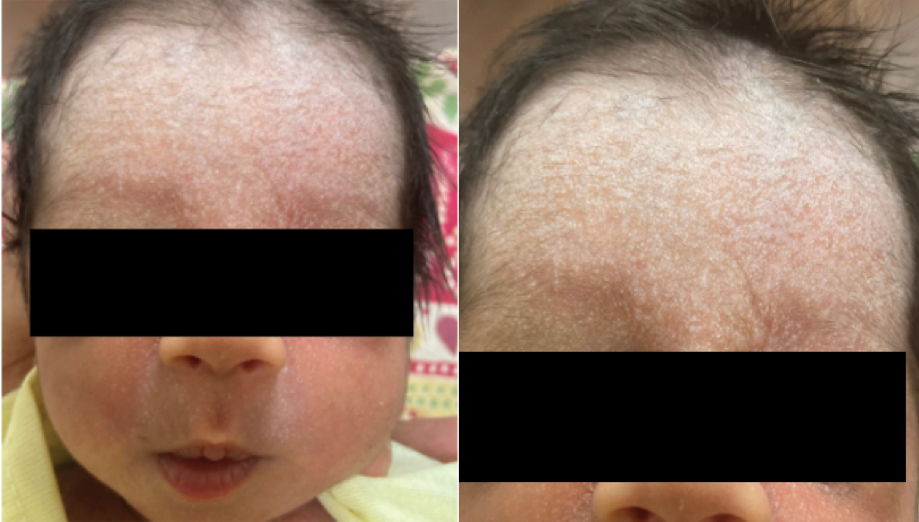We encountered a six-day-old exclusively breastfed male newborn born at term (38+3 weeks) with hyperthermia and skin rashes in the emergency department. At birth, he was 3.32 kg, and at presentation, he weighed 2.89 kg (13% weight loss). His axillary temperature was 38oC. He was healthy on physical examination, and his findings were within normal limits. His heart rate was 160 beats/minute, and his breath rate was 52 breaths/minute at admission, with a capillary refill time of less than two seconds. In addition to hyperthermia, the infant had striking rashes over the face [Figure 1]. Numerous vesicles containing clear fluids of 1–2 mm size were concentrated over his face without erythema or signs of inflammation. The infant also had acute hypernatremia with dehydration (blood urea of 95 mg/dL, creatinine of 1.1 mg/dL, serum sodium of 156 mg/dL, potassium of 5.1 mg/dL, and chloride of 120 mg/dL) and faltering weight, which were managed conservatively. The lesions disappeared within 24 hours after enteral hydration and appropriate thermal care. No intravenous fluids were administered. He was discharged after two days of hospitalization and correction of electrolyte imbalance (serum sodium of 143 mg/dL) with a weight of 3.10 kg and appropriate enteral hydration with breast milk. No clinical features of sepsis were present, and blood cultures obtained for fever were negative. At the follow-up, the infant was growing well. Informed consent was obtained from the patient's mother.
 Figure 1: The appearance of numerous 1–2 mm clear fluid vesicles in a sprinkled dew drops pattern characteristic of miliaria crystalline in a six-day-old newborn.
Figure 1: The appearance of numerous 1–2 mm clear fluid vesicles in a sprinkled dew drops pattern characteristic of miliaria crystalline in a six-day-old newborn.
A clinical diagnosis of miliaria crystallina was made based on clear fluid-filled vesicles without erythema, which is characteristic of the condition.1 It is reported at all ages, especially in intensive care settings, during febrile phases, excessive warmth, and hypernatremia.2,3 It is benign and self-limiting and does not present an underlying serious ailment. The sweat glands are developed at birth in newborns; however, developmental immaturity of eccrine ducts at the level of stratum corneum is postulated for the clinical problem or a role of aberrant sodium homeostasis in the neonatal age group, resulting in clear fluid-filled lesions.2 The published literature also suggests the condition for an intensive care-associated skin ailment with concomitant hypernatremia or hyperthermia, and community-acquired miliaria crystallina from tropical countries.
Miliaria crystallina is confused for congenital herpes simplex, varicella, syphilis, candidiasis, staphylococcal scalded skin syndrome, folliculitis, or pemphigus simplex where the clear fluid vesicles or pus-containing lesions occur with underlying erythema.4 The outcome of miliaria crystallina is excellent, with care directed at controlling temperature and appropriate enteral hydration. The underlying etiology of lactation insufficiency in the index case was addressed through counseling and breast milk was expressed to correct dehydration. Less commonly, desquamation of the lesions may be done in some cases. There is no role for the use of skin emollients for the condition. No investigations are required to confirm the diagnosis of miliaria crystallina. The workup for septicemia was done for the underlying temperature aberrations in the newborn and not for miliaria.
Other subtypes of miliaria include rubra and profunda, which evolve with inflammatory eruptions. The report illustrates benign rashes presented concomitantly with a life-threatening evolution of hypernatremia, which was managed on conservative grounds. The role of elevated serum sodium levels and the concomitant evolution of miliaria crystallina needs to be studied further.
references
- 1. Ferrea MV, Cortés ML, Buoro CV, Flores RM, Perez GO, Carbia SG. Congenital miliaria crystallina due to meconium-stained amniotic fluid. J Eur Acad Dermatol Venereol 2023 Nov;37(11):e1292-e1294.
- 2. Engür D, Türkmen MK, Savk E. Widespread miliaria crystallina in a newborn with hypernatremic dehydration. Pediatr Dermatol 2013;30(6):e234-e235.
- 3. Chao CT. Hypernatremia-related miliaria crystallina. Clin Exp Nephrol 2014 Oct;18(5):831-832.
- 4. Khare C, Murugesan A. A young infant with skin blisters like dew drops over rose petals. Oman Med J 2023 Nov;38(6):e581.